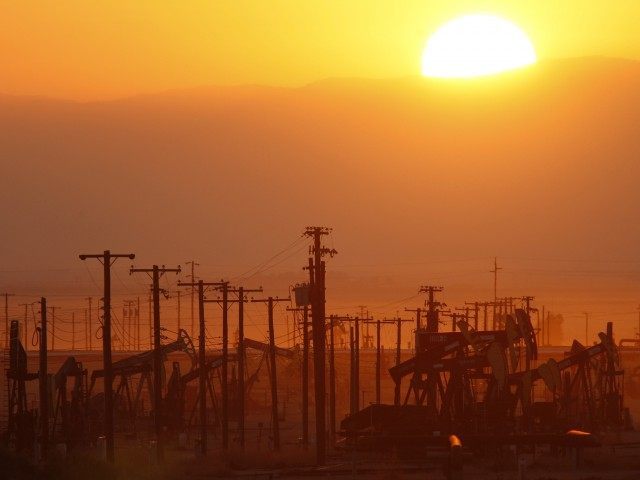California may be on the cusp of an oil fracking boom along its 1,750-square-mile Monterrey Shale Formation, which is potentially the richest shale oil reserve in the United States.
Earthquakes have disturbed the layers of shale rock that run under most of the western state, making fracking more challenging than in a region like North Dakota. But when the next cyclical El Niño brings the huge amounts of water necessary for fracking, California could experience an economic boom similar to North Dakota’s oil rush.
Breitbart News recently noted that “California Is Greece, but with Capital Gains.” A state with terrific beauty and fabulous tech entrepreneurs, it mimics Greece as a failed experiment in liberalism that has the highest poverty rate in the U.S. at 23.4 percent. California is grossly insolvent over the long term with about $500 billion in debt, but remains alive–on life support–as long as the $12 billion of extra capital gains taxes hit each year.
In response to the state’s three-year drought, Gov. Jerry Brown signed an executive order implementing California’s first-ever mandatory water restrictions, which require cities and towns to cut their water usage by 25 percent. In doing so, he specifically exempted oil company water use for fracking. Brown hopes that California can be rescued by a fracking economic renaissance, just like the one that lifted North Dakota from the bottom fifth to the second-richest state by per-capita GDP in just one decade.
In 2005, North Dakota was the tenth-least prosperous state in America. Its average GDP per person at the time was $35,203, about a third less than the $44,745 national average. Agriculture was the largest industry in the “Peace Garden State.” The state was a minor “oil state” that produced about 1.5 percent of total U.S. oil production. Poverty in the rather desolate region was equal to the national average.
But starting around 2007, private wildcatters began drilling successfully for North Dakota’s shale oil using advances in drilling and extraction technologies that allowed what became known as “petropreneurs” to pump a tsunami of previously inaccessible “unconventional oil” in the western Bakken regions of the state.
Between 2007 and 2010, oil production in North Dakota doubled and then doubled again to surpass Wyoming, New Mexico, Oklahoma and Louisiana to make the state America’s fourth largest oil producer by 2010, with 10 percent of national production. The state’s per capita real GDP went above the national average in 2009 for the first time since the 1970s. By 2010, the state had the 12th-highest U.S. per capita real GDP.
From 2009 through 2014, according to Gallup, North Dakota’s fracking boom caused the state to have the highest Job Creation Index scores in the U.S. North Dakota was producing so much shale oil in the Bakken by 2012 that the state passed both Alaska and California to become the nation’s second-largest oil-producing state. Since 2012, North Dakota has held the number two spot in America for per capita real GDP at $64,150, just behind Alaska at $70,437, and 33% above the national average of $48,264.
Over the last decade, North Dakota is one of only three states that actually reduced poverty.
Breitbart News has reported that the U.S. Energy Information Administration believes that the California Monterrey Shale formation appears to be the largest potential region for “tight oil” shale deposits in America, and many operators are already using fracking techniques to drill wells in California.
The Sacramento Bee reported that up to half of the hundreds of new wells drilled each year in the San Joaquin Valley are being “fracked,” according to a study required by the 2013 law regulating the practice.
Zack Malitz of the environmental group Credo complained to Reuters: “Governor Brown is forcing ordinary Californians to shoulder the burden of the drought by cutting their personal water use while giving the oil industry a continuing license to break the law and poison our water.” He added, “Fracking and toxic injection wells may not be the largest uses of water in California, but they are undoubtedly some of the stupidest.”
Gov. Brown has tried to sound high-minded about water use, but the real issue is that California’s State Budget is highly reliant on the oil industry revenues. The blog CalWatchdog.com calculated that the oil and gas industry contributed $21.55 billion to the state’s public fiscus. That amounts to over twice the salary compensation for state employees last year. If Brown cuts oil industry water, he will have to fire state workers.
Still, crude oil production in California has fallen for 27 of the last 30 years, from about 1.15 million to 566,000 barrels per day. California used to be self-sufficient, but now imports 62.8 percent of the petroleum it uses.
Last year, California spent about $32 billion to import 400 million oil barrels of oil.
Governor Brown likely hiopes that an El Niño will hit bringing torrential rainfall–and not just to save lawns and farms. If California can pull off a domestic fracking boom like North Dakota, the economy will take off, poverty will fall and the state will be solvent again.

COMMENTS
Please let us know if you're having issues with commenting.